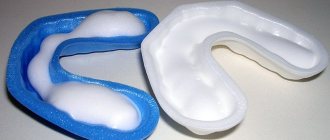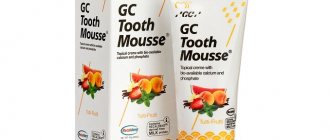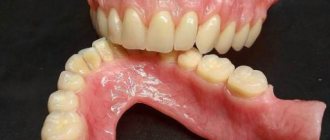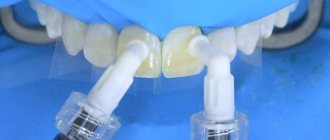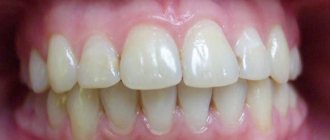Causes of enamel destruction
There are quite a lot of factors that destroy enamel. The most common ones are:
- Poor oral and dental hygiene.
- The use of hygiene products containing aggressive substances that cause demineralization of enamel.
- Disruption of the digestive system.
- Abuse of sweet, sour foods, which chemically affect the top layer of enamel.
- Systematic consumption of energy drinks.
- Smoking. Tobacco contains nicotine, which destroys enamel.
- An incorrect bite causes the tooth enamel to wear away.
- Injury to teeth.
Peculiarities
Patients of dental clinics who wish to undergo enamel implantation should know some of the features of this procedure:
- it is necessary to undergo a preliminary examination of the oral cavity;
- if you have caries or tartar, you will need treatment;
- When diagnosing inflammatory or infectious diseases, antibacterial therapy will be required.
Dental enamel implantation is a procedure that performs a therapeutic, cosmetic and aesthetic function. Provided that the procedure is performed by a highly qualified dentist, the results will impress both the patient and those around him.
Benefits of implantation
The main advantages include:
- The ability to restore tooth enamel at different degrees of destruction.
- Teeth regain their natural smoothness and shine.
- Strengthening dental health from exposure to external irritants.
- Prevention of the development of dental diseases, especially caries.
Indications for the use of enamel implantation:
- damage to the enamel, disrupting the aesthetics of the tooth;
- decrease in the level of minerals and salts in tooth enamel;
- development of pathology, accompanied by the appearance of spots on the enamel;
- expansion of interdental gaps;
- malocclusion.
Dental enamel implantation
The most effective method of restoring an attractive smile and getting rid of the discomfort associated with enamel damage is its implantation. Firstly, the procedure is absolutely painless - patients do not experience even trivial discomfort, no preliminary preparation is required, and there is no need to undergo a full examination, as is the case with the use of anesthesia. Secondly, implantation of dental enamel allows you to maximally load the entire dentition without fear of splitting or separation of the implants. Thirdly, such “onlays” have a long service life, and their fixation at the molecular level with dental tissue makes them unrecognizable - it is difficult for non-specialists to determine the dentist’s intervention.
Results of dental enamel implantation:
- incorrect bite is corrected - this eliminates the need to wear braces, but results are only possible for minor (non-pathological) violations;
- the color of the teeth is corrected - if desired, you can make them dazzling white;
- a dental defect is corrected - enamel implantation performs an aesthetic task;
- patients get rid of increased sensitivity - hot, cold, sour, salty can now be consumed without fear of provoking a powerful painful attack;
- The shape of the teeth changes - not dramatically, but minor imperfections are removed.
Other ways to restore enamel
- Filling, which is prescribed in the complete absence of a layer of enamel. The filling material is applied in a thin layer to the tooth, and after hardening, the chewing element takes on a healthy appearance with smooth and shiny enamel.
- Fluoridation. This is the most famous and accessible method of restoring enamel, in which a substance containing fluoride is applied to the teeth. Fluoride comes in gel form. After fluoridation, teeth become smooth and shiny.
- Microprosthetics, when a veneer or lumineer is attached to damaged teeth. The procedure is effective, but expensive.
- Remineralization. A procedure in which calcium phosphate is applied to the teeth. Over time, the applied substance becomes durable and is able to protect teeth from external irritants. This method of restoring enamel is used only when it is partially destroyed. If there is a complete absence of enamel, the method is not effective.
At the first signs of tooth hypersensitivity, you should immediately contact a dentist, who can determine the cause of tooth hypersensitivity. After diagnosis, the doctor will prescribe a course of treatment.
What it is?
The main role of whitening varnish is to temporarily mask the pigmented surface of the crowns.
Many people compare the functions of this product with foundation. It is also applied to the enamel, covering it with a glossy layer, the color of which is several times whiter than the crowns.
Unlike other lightening agents, varnish allows you to even out the color even in filled teeth. The product is easy to use and does not require special preparation of crowns.
The main components in them are :
- protective film-forming agent;
- titanium dioxide , which performs a coloring function;
- mineral and fluoride additives , such as hydroxyapatite and fluorides.
The use of varnish is recommended to strengthen the enamel in case of poor quality, pigmentation and uneven surfaces (cracks, small chips).
It is common to use the product for photo and video filming or important life events, since the corrector makes it possible to obtain instant results.
Manufacturers often guarantee that the layer will remain intact for 12-24 hours, but often its integrity is compromised within 4 hours of application.
Prices
Aesthetics
- Professional teeth whitening using the “Zoom” device (up to 20 teeth) I category of complexity
To order - Professional teeth whitening using the “Zoom” device (up to 20 teeth) II category of complexity
from 30 000
- Whitening (1 tooth)
950
- Home whitening (set when using ZOOM)
15 000
- Making a tray for whitening (1 jaw)
10 000
- Skyce fixation (1 tooth)
2 000
To make an appointment, call:
- On Izmailovskaya
+7(495)
226-3-888
+7(985) 226-3-888 - On Shchelkovskaya
+7(495)
924-45-44
+7(985) 924-45-44 - On Ryazansky Prospekt
+7(495)
728-03-33
+7(903) 728-03-33 - On Aviamotornaya
+7(495)
647-6-333
+7(903) 247-6-333 - On Rokossovsky Boulevard
+7(495)
226-5-888
+7(985) 226-5-888 - or
Leave a request
and we will call you back
Reviews
Enamel implantation is not suitable for everyone, but those who have tried this method of restoring teeth on themselves are convinced of the good aesthetics and reliability of the restoration.
But, along with positive opinions, this method also receives negative reviews. You can share your own impressions about the enamel implantation procedure in the comments below.
If you find an error, please select a piece of text and press Ctrl+Enter.
Tags: tooth enamel implantation
Did you like the article? stay tuned
Previous article
Causes of suture dehiscence after dental implantation and how to avoid the consequences
Next article
Frankly about the pros and cons of advanced dental implantation methods
Advantages of the RUTT clinic
In Moscow, restoration is carried out in almost all clinics. It is important to choose one that does it well.
IN ICDI ROOTT:
- Modern composite materials
are used . They are less susceptible to shrinkage and cracks, wear-resistant and durable. - It has its own technical laboratory
. You won’t have to overpay intermediaries and production times will be shorter. - Reception is conducted by qualified doctors who are constantly learning. All new methods are immediately put into practice.
- Customer support service
is available . Any question will be answered there.
All consultations at the clinic are free of charge.
.
Remineralization methods
As has already become clear from the above, there are only two methods of remineralization - natural and dental. And when natural self-regulation mechanisms malfunction, modern medications come to the rescue.
Artificial
Is it possible to cover teeth with artificial enamel? Of course, this will not be tooth enamel in the usual sense, but rather a protective composition that will compensate for the lack of minerals. Such formulations are divided into two types: fluoride-containing preparations and preparations without fluoride.
The first includes, for example, remineralization of teeth with calcium-fluoride varnish or simply fluoride varnish. Usually it is applied to the teeth with a brush in several stages, but it can also be used using special mouth guards made from a cast of the teeth. Preparations without fluoride are usually used to consolidate the effect of the above-described treatment.
Deep fluoridation is carried out using simultaneously two liquids that interact with each other inside the enamel, creating strong compounds of fluoride and calcium and a protective film on the surface of the tooth, which prevents the newly created compounds from being washed out for a long time.
Another way to artificially strengthen the enamel structure is electrophoresis , in which fluoride or calcium ions are introduced into the bone tissue of the tooth with weak current discharges.
Natural
The antibacterial and restorative properties of human saliva have been known for a long time, but what to do if saliva does not fulfill its functions and the enamel layer is gradually destroyed? The use of special medicated toothpastes, rinses, gels and other preparations containing minerals important for teeth such as phosphorus, fluorine and calcium can help the enamel to regenerate itself.
To restore the natural properties of saliva, it is recommended to drink plenty of water, eat right and take vitamin and mineral complexes that compensate for the lack of nutrients in the body. Of course, nowadays, covering teeth with enamel is not at all problematic, but no amount of artificial enamel can compensate for the damage done to the teeth.
Recommendations after teeth augmentation
If anesthesia was used, then you should refrain from eating for 2-3 hours. If no anesthesia was given, then there are no restrictions on food intake.
During the first days, you should avoid foods that are too cold or too hot. It is better to give up seeds and nuts forever.
Composites easily absorb pigments, so tea, coffee, red wine and dark berries can change the color of the restoration.
When using composite building on the front teeth, it is recommended not to bite off hard fruits and vegetables, but to first cut them into pieces.
Avoid hard brushes and abrasive pastes as composites will scratch and lose their appearance. But irrigators, dental floss and brushing your teeth 2 times a day will help preserve your and restored teeth for a long time.
Article Expert
Milyev Semyon Konstantinovich Dentist-therapist, doctor of the highest category
Work experience: more than 6 years
In what cases is it recommended to coat teeth with varnish?
The protective properties of enamel are due to the strength of the bonds in its crystal lattice formed by calcium mineral compounds (hydroxyapatites).
In addition to performing a barrier function, this layer of crowns ensures the transparency and shine of healthy teeth when exposed to sunlight.
If the chemical bonds in hydroxyapatite prisms are weakened, mineral substances are gradually washed out from the hard tissues of the tooth (demineralization) and the enamel becomes thinner. At the same time, the affected tooth loses its shine and becomes darker.
After the completion of the physiological processes of mineralization, active proteins of the enamel matrix and stem cells disappear in the hard tissues of teeth. The absence of these structural components explains the impossibility of producing a replacement mineral coating in mature tooth enamel and the formation of new hydroxyapatite prisms in the crystal lattice.
At the initial stages of demineralization of hard tooth tissues, it is possible to slow down the rate of development of destructive processes and partially restore the damaged enamel surface artificially. For this purpose, the following treatment methods have been developed in dentistry:
- Coating the surface of teeth with gels and varnishes containing simple fluorides (NaF).
- Deep fluoridation is the saturation of hard tooth tissues with mineral compounds by treating damaged surfaces with preparations that contain complex fluorine compounds (CaF2). Thanks to this, the therapeutic effect in comparison with the use of fluoride-containing varnishes is enhanced 100 times.
- Physiotherapeutic treatment – strengthening the structure of tooth enamel by introducing fluoride and calcium ions into it using low-frequency electric current discharges (electrophoresis).
- Enamel implantation is an innovative technique developed by American scientists. Only this treatment method allows you to restore fairly large damaged areas of tooth enamel. Along with the therapeutic effect, after enamel implantation, the appearance of teeth improves - the use of this technology helps to lighten their surface by up to 10 tones.
Fluorine-containing composition can only be used as prescribed by a doctor. Indications for coating the surface of teeth with varnish are as follows:
- treatment of hyperesthesia;
- protecting teeth from the aggressive effects of acids, for example, if there is a history of gastroesophageal reflux;
- temporary anesthesia of dental units ground before installing artificial crowns;
- protection and restoration of the enamel surface after removal of braces or cosmetic teeth whitening;
- slowing down the processes of destruction in the hard tissues of the tooth in the presence of the first signs of caries formation (stain stage). The most effective results in reducing the caries process are observed when treating baby teeth.
Recent developments in the pharmaceutical industry have led to the creation of fluoride varnish, which not only helps strengthen tooth enamel, but also acts as a paint. After applying such products, a short-term cosmetic effect is achieved - the surface of the teeth is instantly evened out in color, lightened by several tones, and the painted edges of the fillings are masked.
Advantages and disadvantages
However, varnishes for instantly brightening crowns are popular.
This is due to a wide range of advantages :
- the product allows you to make your teeth not just lighter than they are, but to give them the snow-whiteness of a “Hollywood” smile;
- in 5 minutes you can whiten crowns by 10 shades or more;
- varnishes are absolutely safe for dental and periodontal tissue;
- most correctors from different manufacturers contain remineralizing additives, which additionally allows for permanent whitening;
- The cost of this method is significantly lower than other whitening methods.
Read how effective the Blik pencil is for teeth whitening in a new publication.
In the following article you will find a recipe for teeth whitening with activated carbon.
Here https://www.vash-dentist.ru/krasota-i-uxod/zubnyie-pastyi/president-vidyi-opisanie-i-otzyivyi.html we have collected reviews about the President whitening toothpaste.
The disadvantage of these products is the low strength of the resulting layer. When eating solid food or other strong mechanical stress, the layer is easily removed.
Most often, users are confused by the fact that some types of varnishes are difficult to apply exactly the first time. Without some experience, the layer turns out to be uneven and you have to spend a lot of preparation and time.
Features of the procedure in dentistry
In dental offices, fluoride-containing preparations are applied to the surface of teeth in two ways:
- brush or spatula-shaped stick;
- using special trays made individually for each patient based on impressions of his dentition.
Before applying the drug, the dentist cleans the surface of the enamel from soft plaque, slightly dries it with a stream of air and, using gauze swabs, isolates the teeth from saliva.
Features of the use of fluoride composition depend on its type and are determined by the manufacturer. The number of procedures required to achieve a therapeutic effect is prescribed by the attending physician.
